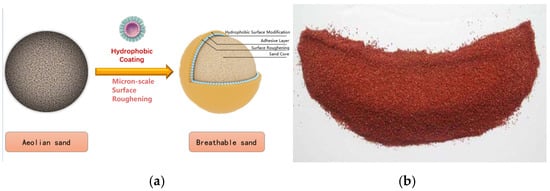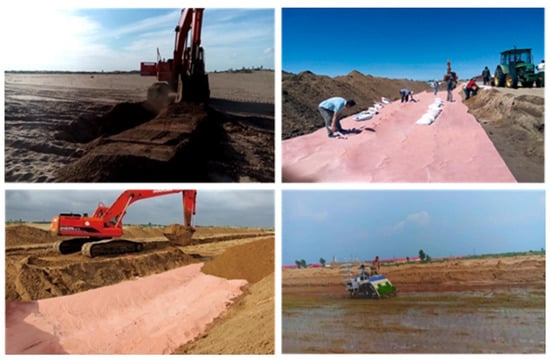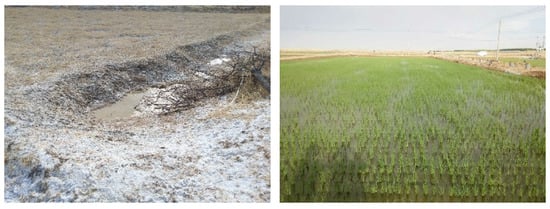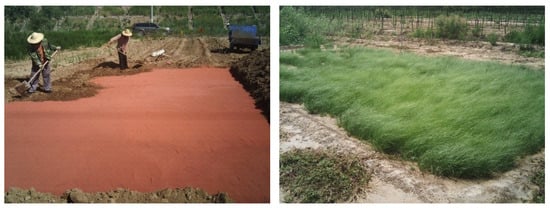Abstract
An innovative air-permeable watertight material (hereinafter “Breathable Sand”) was invented and has been used in various agricultural applications. Proprietary coating and surface modification processes are applied on desert sand particles, and thus the air permeability can be retained, while the material is watertight due to its water repellency properties. Breathable Sand has been used as a liner in salt-affected fields in Inner Mongolia and Tianjin in China. After years of its initial application, no salt intrusion in the root zone was observed. In addition, studies in Zhejiang Province showed that about a 30% water saving can be achieved with 3 cm of Breathable Sand applied below the roots in rice fields, compared to conventional rice fields. Roots were stronger and the average leaf count, grain weight, grain per ear, matured grain count, and grain maturity rates were also higher.
1. Introduction
Worldwide, over 1100 million hectares of soils are affected by salinity and sodicity, including saline, sodic, and saline-sodic affected lands [1]. In China, according to the results of the Second National Soil Survey, there are more than 33 million hectares of salt-affected land, of which about 13 million hectares have the potential for agricultural development [2].
Modern coated sand has been studied and used in various fields, including some agricultural applications. Some studies showed that specially coated sand with surface modifications, when applied under plant root zones, can significantly reduce water consumption in arid land [3]. However, applications are sporadic.
In this study, aeolian sand was treated and a new engineered sand material was invented and developed. State-of-the-art treatment processes were developed, which allowed sand from the desert to meet various engineering needs. Thanks to the coating, surface roughening, and surface modification processes, a new air-permeable watertight sand material (hereinafter “Breathable Sand”) was invented by Rechsand Science & Technology Group (hereinafter “Rechsand”) [4]. It has been used in stormwater harvesting, building construction, agricultural soil modification, water treatment, and reverse desertification projects in China, including salt-affected soil management sites in Dengkou City, Inner Mongolia, and Tianjin City.
2. Materials
Aeolian sand (typical particle size D50 = 65–149 microns) was used as the core material, and a series of proprietary pre-treatments and surface modification processes were used to form at least two nanoscale layers on individual sand particles (Figure 1).

Figure 1.
Breathable Sand: (a) conceptual illustration of the coating, surface roughening, and surface modification processes; (b) Breathable Sand product.
3. Methodology
3.1. Use Breathable Sand as a Liner—Agricultural Applications
Breathable Sand has been used in agricultural and afforestation applications under different climate and soil conditions in China, such as Inner Mongolia, Ningxia, Gansu, Xinjiang, Beijing, Zhejiang, etc. A typical sequence of agricultural land preparation is shown in Figure 2.

Figure 2.
A typical sequence of agricultural land preparation: excavation, Breathable Sand layer preparation, backfilling, and planting.
In this study, water usage and plant growth were monitored to evaluate the effects of utilizing Breathable Sand as a liner. Hybrid late rice in three adjacent lots (one control/without a liner, one with a geotextile liner, and one with approximately 3 cm of Breathable Sand liner) in a demonstration farm in Zhejiang Province was monitored in the summer of 2019. Irrigation water use, root and leaf development, and rice quality and yield from the three lots were monitored and compared.
3.2. Case Studies of Salt-Affected Soil Management
Salt-affected soil applications with Breathable Sand are similar to regular agricultural land applications, but ex situ cultivatable soil is typically needed during backfills. Salt-affected soil management projects have been conducted in Dengkou City, Inner Mongolia, and Tianjin City in China since 2017, which are introduced in this paper.
4. Results
4.1. Breathable Sand Properties
The finished Breathable Sand retains its air permeability feature due to its unchanged porous nature from untreated sand, while can withstand certain water pressure without becoming wet due to its water repellency properties. Tests were conducted and the results are summarized in Table 1. These features also allow Breathable Sand to be applied in salt-affected lands as a barrier to prevent salts in the deeper sodic soils from reaching the plant root zone.

Table 1.
Water pressure resistance and air permeability of Breathable Sand.
4.2. Breathable Sand in Agricultural Applications
The Breathable Sand liner has a positive impact on the plant’s root and leaf development during the growing season, indicating that the air-permeable feature may potentially enhance nutrient uptake and plant growth. The quality and quantity of rice yield with Breathable Sand also exceeded those without a liner. The average root weight, leaf count, grain weight, grain per ear, matured grain count, and grain maturity rates were 1.0%, 5.5%, 0.6%, 1.3%, 4.8%, and 3.3% higher than those without a liner, respectively (See Table 2). Moreover, monitored water use showed that 29% water saving was achieved with Breathable Sand, compared to that without a liner, which is close to that achieved with a geomembrane liner.

Table 2.
Rice leaf and root development, yield, and water use comparison.
4.3. Breathable Sand Applications—Salt-Affected Soil Management Results
Breathable Sand has been used as a liner in a salt-affected field in Dengkou, Inner Mongolia since 2017. Both desert sand and clean ex situ sandy soil from adjacent land were used in the backfill. Hybrid rice, as well as local grass, was used in the demonstration. The before-and-after photos are shown in Figure 3.

Figure 3.
Salt-affected land, rice field site before and after Breathable Sand treatment (Inner Mongolia, China).
After four years of the initial application, there are no visual signs of plant depression or salt intrusion observed. Similar results were also achieved in Tianjin City, as shown in Figure 4.

Figure 4.
Salt-affected land, during and after the Breathable Sand treatment (Tianjin, China).
5. Conclusions
A coated sand-based material with surface modifications, called Breathable Sand, was invented. The material is watertight yet air-permeable. These features allow it to be used as a liner in many agricultural projects, including salt-affected land management in Inner Mongolia and Tianjin in China, which are introduced in this study. Breathable Sand installed under the plant root zone can significantly reduce water infiltration, and avoid salt intrusion from the subsoil. Field studies also showed that 29% of water-saving, stronger root and leaf development, and higher crop quantity and quality were achieved from rice fields with 3 cm of Breathable Sand liner, compared to those from conventional fields.
Author Contributions
Conceptualization, S.Q.; methodology, Y.S. and S.Q.; writing—original draft preparation, Y.S. and C.D.; writing—review and editing, C.D. All authors have read and agreed to the published version of the manuscript.
Funding
This research received no external funding.
Institutional Review Board Statement
Not applicable.
Informed Consent Statement
Not applicable.
Data Availability Statement
No new data were created or analyzed in this study. Data sharing is not applicable to this article.
Conflicts of Interest
The authors declare no conflict of interest.
References
- Food and Agriculture Organization of the United Nations. Harmonized World Soil Database (Version 1.0); FAO: Rome, Italy; IIASA: Laxenburg, Austria, 2008. [Google Scholar]
- Wang, Y.; Kong, X. The Protective Development of Saline-Alkali Land is Urgent. The Economic Daily, 13 April 2021. Available online: https://www.chinanews.com/gn/2021/04-14/9454569.shtml (accessed on 24 January 2021). (In Chinese).
- Salem, M.; Al-Zayadneh, W.; Cheruth, A. Water Conservation and Management with Hydrophobic Encapsulation of Sand. Water Res. Manag. 2010, 24, 2237–2246. [Google Scholar] [CrossRef]
- Rechsand’s Breathable Sand in Agricultural Applications. Available online: https://www.rechsand.com/index.php/Pr_index_gci_40.html (accessed on 24 January 2022). (In Chinese).
Publisher’s Note: MDPI stays neutral with regard to jurisdictional claims in published maps and institutional affiliations. |
© 2022 by the authors. Licensee MDPI, Basel, Switzerland. This article is an open access article distributed under the terms and conditions of the Creative Commons Attribution (CC BY) license (https://creativecommons.org/licenses/by/4.0/).